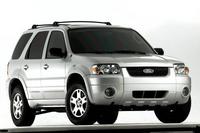2005 Car Review: Ford Escape XLS 2WD
THE AUTO PAGE
By
JOHN HEILIG
SEE ALSO: New Car Buyer's Guide for Ford
SPECIFICATIONS
MODEL:
ENGINE: 2.3-liter I-4
HORSEPOWER/TORQUE: 153 hp @ 5,800 rpm/152 lb.-ft. @
4,250 rpm
TRANSMISSION: 4-speed automatic
WHEELBASE : 103.1 in.
LENGTH x WIDTH x HEIGHT : 174.9 x 70.1 x 69.7 in.
TIRES : P225/75R15
ECONOMY:: 21 mpg city/24 mpg highway
PRICE: $19,405 (base)
There are several versions of the popular Ford Escape that have escaped into the public. There are the Ford Escape with a 2.3-liter four-cylinder engine - our tester. There's the Escape with a 3.0-liter V6. There's the Escape Hybrid. There are a couple of Mazda Tributes that are essentially identical to the Escape, and there is the new-for-2005 Mercury Mariner, with is an Escape V6 with a totally different exterior and interior.
Our tester is the four-cylinder Escape. The engine seems a bit underpowered, even though it's an improvement from the `04's 127 hp 2.0-liter four. This engine produces 153 horsepower. While it's more than enough to help the 2WD Escape keep up with the traffic around it and even occasionally exceed posted speed limits, it's noisy, as are most four-bangers. Personally, I prefer the V6 versions, and having driven a couple of the Escape iterations that's the way to go. Fuel economy is 2-4 mpg greater with the six, though, so if that's a concern you may want the four. If it's really a concern, get the hybrid.
There's a ton of room under the hood for DIYers to work on the engine themselves. Also, dip sticks and fillers are clearly marked and easy to find and get to.
There is also a choice of four-speed automatic or five-speed manual. As you can see from the spec box, we had the automatic. This year, the shifter has been moved form the column top the floor.
But no matter which engine/transmission combination you choose, the Escape is a good package. It has decent size for maneuverability and parking, and with 66.3 cubic feet of cargo space, it can be a work pony as well.
Normally, the Escape qualifies as a four-passenger vehicle. You can pull the rear seat cushions forward and fold the seat backs (60/40) to create an almost-flat cargo floor that is 66 inches long and more than 40 inches wide. The tailgate, like the Explorer's, can lift up, or you can life just the glass, making it more practical.
Our tester also had a shade to cover the cargo in the rear and keep what was there from prying eyes.
The family resemblance to the Explorer and larger Ford SUVs is there, of course. Like the other Fords, the Escape has all the features you'd want, except ion the case of our tester, all-wheel drive of any sort. Ours was strictly a boxy station wagon, which isn't a bad thing.
One thing I liked about our Escape was that it wasn't overloaded with goodies that add thousands to the base price. We had cloth seats that were manually adjustable. And when you think about it, power seats are nice, but once they're set, you don't need the power anyway. For the extra effort, the cost savings is worth it. We did have power mirrors and windows, though, with a remote door lock and unlock.
Handling was very good, both on the highway and on winding mountain roads. We have discovered a new windy, hilly test road that puts any vehicles through its paces. The Escape did well both going up and down. We had four-wheel disc brakes with ABS that helped, but I was able to maneuver well through some pretty tight turns. I discovered that when I was driving the Escape Hybrid in some off-road situations that it was very capable as well.
Entry into the Escape is aided by assist handles at the front doors. There were none at the rear doors.
For entertainment there was an AM/FM/CD player. The HVAC system was manual (not digital) but did the job on a couple of cold evenings.
The instrument panel consisted of the standard four gauges. The tachometer and speedometer had black numbers on a white background, while the fuel and water gauges had the reverse and were smaller.
Cruise control switches were located on the steering wheel.
For storage, there was a huge console box, a cubby in front of the shifter, pockets in the doors, and two cupholders in the center console, one with an ash tray insert that could be removed. There were two 12V outlets, once the lighter was removed.
For safety, there were the standard two front airbags plus curtain airbags on the side.
The Escape is a good size and good value. With the various combinations of engine and transmission, you can configure the Escape almost any way you want it.
© 2004 The Auto Page Syndicate



